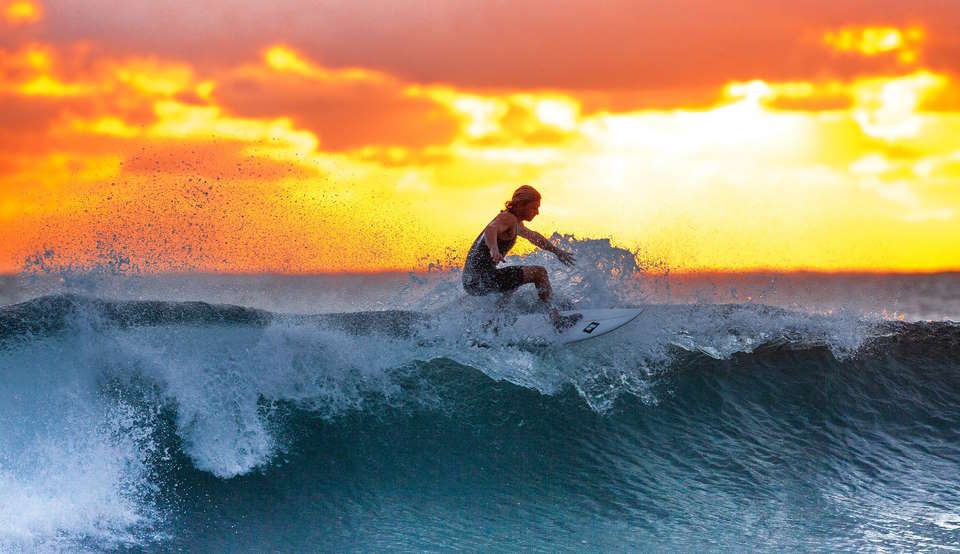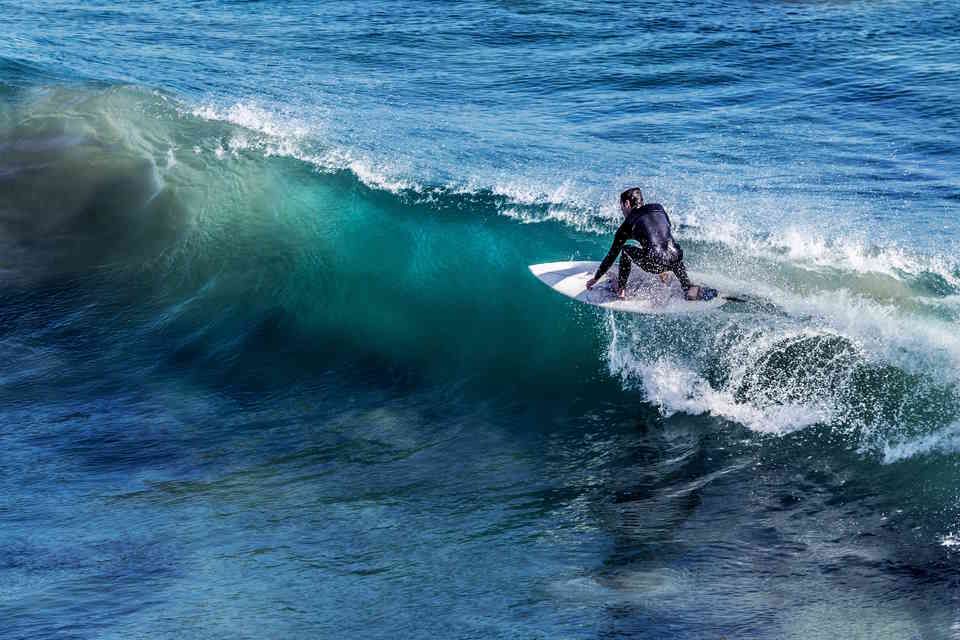Surfing is a popular water sport that is enjoyed by millions of people around the world. If you’re a beginner surfer or just curious about how these boards are made, then this is for you! We’ll explore what materials are used to make surfboards and what surfboards are filled with. We’ll also discuss if surfboards are made of metal and if expensive surfboards are made of different materials than cheaper ones. Additionally, we’ll take a closer look at surfboard resin and what it’s made of. So, let’s dive into the world of surfboards and explore what makes them so unique!

Introduction

Surfboards are the iconic symbol of surfing culture and are essential equipment for anyone who wants to ride the waves. But have you ever wondered what surfboards are made of? We will explore the different materials used in making surfboards and their properties.
- Foam Core: The most common material used to make the core of a surfboard is foam. The foam core is usually made from expanded polystyrene (EPS) or polyurethane (PU) foam. EPS foam is lightweight and easy to shape but not as durable as PU foam. On the other hand, PU foam is more durable but heavier than EPS foam. The foam core is the foundation of the surfboard, and its properties can affect the performance of the board in the water.
- Fiberglass and Polyester Resin: The foam core is then covered with layers of fiberglass cloth and coated with polyester resin. Fiberglass is a strong and lightweight material that provides structural support to the foam core.
- Carbon Fiber: Carbon fiber is a more expensive option used to make high-performance surfboards. It is stronger and more lightweight than fiberglass, but also more expensive.
- Other Materials: Other less common materials used in making surfboards include wood, metal, and epoxy. Wood surfboards are made by laminating thin layers of wood veneer around a wooden frame. Metal surfboards are rare and are often used in art installations. Epoxy surfboards are made using epoxy resin instead of polyester resin and are known for their strength and durability.

| Materials | Properties | Uses |
|---|---|---|
| Expanded polystyrene (EPS) foam | Lightweight and easy to shape but less durable | Beginner surfboards |
| Polyurethane (PU) foam | More durable but heavier than EPS foam | Standard shortboards |
| Fiberglass cloth | Strong and lightweight | Structural support for the foam core |
| Polyester resin | Forms a protective coating over the fiberglass cloth and foam core | To make the board water-resistant and more durable |
| Carbon fiber | Lightweight and strong but expensive | High-performance surfboards |
What Materials Are Used to Make Surfboards?

Surfing is a popular water sport that requires the use of a surfboard. Surfboards come in different shapes and sizes, but have you ever wondered what materials are used to make them? We will take a closer look at the materials used in the construction of surfboards.
The core of a surfboard is typically made of foam, which can be either polystyrene or polyurethane. Polystyrene foam is lighter and easier to shape, while polyurethane foam is denser and more durable. The foam core is shaped into the desired shape and size of the surfboard, and then coated with fiberglass or other materials to provide strength and durability.
-
- Fiberglass:
Fiberglass is the most common material used to cover the foam core of a surfboard. The fiberglass is coated with a layer of resin to provide a smooth and strong surface. Fiberglass is lightweight, durable, and flexible which makes it an ideal material for a surfboard.

Epoxy is an alternative to polyester resin and is often used for surfboards that require a bit more durability. Epoxy resin is often coupled with expanded polystyrene (EPS) foam, which is waterproof and lightweight. This combination makes for a strong and lightweight surfboard that can last a long time.
-
- Carbon Fiber:
Carbon fiber is a high-performance material that is used in some of the most expensive surfboards in the world. It is lightweight, strong, and adds stiffness to the surfboard. Carbon fiber is mainly used in the rails, tails, and fins of the surfboard to increase performance.
| Materials | Advantages | Disadvantages |
|---|---|---|
| Fiberglass | Lightweight, durable, flexible | Not as strong as other materials, can yellow over time |
| Epoxy | Durable, waterproof, lightweight | More expensive than fiberglass, not as easy to shape |
| Carbon Fiber | Strong, lightweight, adds stiffness | Expensive, can be brittle if not handled carefully |
Are Surfboards Made of Fiberglass?

Surfing is an adrenaline-pumping sport and the surfboard is the most essential equipment required to enjoy it. It plays a major role in determining how enjoyable the surfing experience is. A surfboard is made up of several different materials, and one of these materials is fiberglass.
Fiberglass is a material that consists of thin strand-like pieces of glass that are woven together to form a fabric. The fiberglass fabric is then bonded together with a type of resin to create a strong, lightweight, and durable material that can be used to make a surfboard. The use of fiberglass in surfboard construction began in the 1950s, and it has since become a widely popular material used by most surfboard manufacturers.
- Why is fiberglass used?
Fiberglass is used in surfboard construction because it is strong and lightweight. It allows manufacturers to create surfboards that are durable, which can withstand the rigors of the ocean waves, and can be easily transported. Fiberglass also has excellent resistance to water, which makes it ideal for use in surfboard construction.
In addition to being strong, lightweight, and durable, fiberglass can also be molded into different shapes and sizes. This means that surfboards can be customized to fit the surfer’s preferences, whether they prefer shortboards, longboards or something in between. Fiberglass surfboards can also be designed to have a specific level of flex, which can affect how the board performs on the waves.

- Are there any disadvantages to using fiberglass?
There are some disadvantages to using fiberglass in surfboard construction. One of the biggest disadvantages is that fiberglass can be prone to cracking or breaking if the board takes a severe impact. Fiberglass surfboards also require regular maintenance, which includes repairing any cracks or dings that may occur during use. Additionally, the chemicals used in the fiberglass manufacturing process can be harmful to the environment.
| Advantages | Disadvantages |
|---|---|
| Strong and lightweight | Proneness to cracking or breaking |
| Durable | Requires regular maintenance |
| Can be customized | Chemicals used in the manufacturing process can be harmful to the environment |
| Water-resistant |
What Are Surfboards Filled With?

Surfboards are an essential accessory for any avid surfer. They allow surfers to catch waves and ride them with ease. While most people know what surfboards are made of, they might not know what they are filled with. The filling, also known as the “core” of a surfboard, is a crucial component as it determines the board’s weight, buoyancy and overall feel. We’ll take a closer look at what surfboards are filled with and how it affects their performance.
Traditionally, surfboards were made with a core of balsa wood or foam. Balsa wood was the primary material used before foam became more popular in the early 1960s. Since then, polyurethane foam has become the most common core material for surfboards. The foam is lightweight, buoyant, and easy to shape. High-density foam is used for the deck and bottom of the board for added strength and durability. The foam is cut, shaped, and then covered with fiberglass and resin to create the final product.
- Another material that is used for surfboard cores is Expanded Polystyrene (EPS) foam. EPS is a type of foam that is commonly used in packaging materials due to its light weight and insulating properties. It is more expensive than polyurethane foam, but it is also durable, strong, and eco-friendly, which makes it a popular choice among green-conscious surfers.
- Some surfboard manufacturers also use extruded polystyrene (XPS) foam, which is similar to EPS foam but has higher density and rigidity. XPS foam is hard and brittle, making it difficult to shape and work with. It is mostly used for creating high-performance shortboards that require a stiffer, more responsive feel.

Surfboards can also be filled with other materials like carbon fiber, Kevlar, and bamboo. While these materials are not commonly used, they offer unique benefits like added strength, stiffness, and responsiveness. Carbon fiber and Kevlar are lightweight yet strong, which makes them ideal for creating high-performance surfboards that can handle larger, more powerful waves. Bamboo, on the other hand, is a sustainable alternative to foam that provides a unique look and feel to the board. Some surfers also claim that bamboo core boards have a more lively, responsive feel in the water.
| Foam Core Type | Pros | Cons |
|---|---|---|
| Polyurethane | Low Cost, Easy to Shape, Widely Available | Can be Damaged Easily, Not Eco-friendly |
| Expanded Polystyrene (EPS) | Strong and Durable, Eco-friendly | Expensive |
| Extruded Polystyrene (XPS) | Stiff and Responsive, Ideal for high-performance shortboards | Brittle and Difficult to Shape, Expensive |
There are many materials that a surfboard can be filled with, each with its own benefits and drawbacks. It is important to choose a filling that works best for your surfing style and ability. Whether you want a lightweight board for catching small waves or a high-performance board for charging larger, more powerful surf, there is a surfboard filling out there that will meet your needs.
What Are Expensive Surfboards Made Of?

When it comes to surfing, the most important equipment is the surfboard. It is essential in providing stability and helping surfers ride the waves. While there are a variety of surfboards available in the market, the expensive ones stand out in terms of quality, durability, and performance. Have you ever wondered what makes expensive surfboards so special and what materials are used to make them? Let’s have a look.
Expensive surfboards are typically made of high-quality materials that are more durable and offer better performance, lasting longer than cheaper surfboards. Some commonly used materials include carbon fiber, epoxy resin, and high-density foam. Carbon fiber has a high strength-to-weight ratio and is very lightweight, which makes it an excellent material for surfboards. Epoxy resin is a more durable alternative to polyester resin and offers better UV resistance. High-density foam is strong and lightweight, helping surfers get more speed while riding the waves.

Another important factor that sets expensive surfboards apart is the manufacturing process. High-end surfboards are typically handcrafted, rather than mass-produced. This means each surfboard is made with care and attention to detail, ensuring that the board is perfectly suited to the rider’s needs. The manufacturing process is also more time-consuming, which adds to the cost of the surfboard. However, the resulting product is of higher quality and better performance, making it worth the investment for serious surfers.
| Materials Used in Expensive Surfboards | Advantages |
|---|---|
| Carbon Fiber | High strength-to-weight ratio and lightweight |
| Epoxy Resin | More durable than polyester resin and offers better UV resistance |
| High-Density Foam | Strong and lightweight, provides more speed while surfing |
What Is Surfboard Resin Made From?

Surfboards have come a long way from the traditional wooden boards used by the ancient Hawaiians. Nowadays, most surfboards are made of foam and fiberglass. However, one of the most important components of a surfboard is the resin. Surfboard resin ensures the fiberglass stays attached to the foam core and gives the board its sturdy exterior.
So, what exactly is surfboard resin made of? Most surfboard resins are made of polyester or epoxy. Polyester resin is often used in the production of surfboards because it is affordable and dries relatively quickly. However, it has a few downsides, including being prone to cracking and yellowing over time. Epoxy resin is slightly more expensive than polyester but is more durable, lighter, and less likely to yellow over time.
- Polyester Resin
- Epoxy Resin
Aside from its structural function, surfboard resin also adds a bit of personality to the design. There are many different colors and designs available when it comes to surfboard resins, so it provides a way for surfers to create their own unique board.

| Polyester Resin | Epoxy Resin |
|---|---|
| Pros: | Pros: |
|
|
| Cons: | Cons: |
|
|
Ultimately, the choice between polyester and epoxy resin comes down to personal preference. Whether you want a more affordable option or a durable, lightweight board, both resins have their own unique pros and cons. It’s worth considering them both and discussing with a surfboard shaper to determine which is the best option for you.




